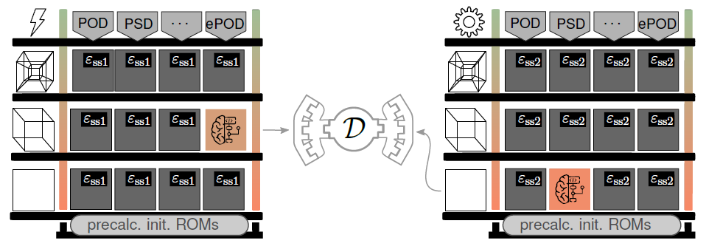Researchers from the Cluster of Excellence SimTech at the University of Stuttgart have secured a three-year grant from the German Research Foundation (DFG) to develop next-generation simulation techniques for multiphysical engineering systems. The project is led by Jörg Fehr (Institute for Engineering and Computational Mechanics, ITM) and Bernard Haasdonk (Institute for Applied Analysis and Numerical Simulation, IANS), both participating researchers at SimTech.
Adaptive Modeling for Practical Engineering Challenges
Titled “Adaptive Goal-Oriented Hierarchical Surrogate Modeling for Port-Hamiltonian Multiphysical Systems”, the project aims to bridge engineering, computational mathematics, and machine learning. Its goal is to create hierarchical surrogate models that significantly reduce computational costs in simulation – without compromising physical fidelity.
At the core of the project lies the port-Hamiltonian (pH) modeling framework, which ensures that energy flows and interactions across physical domains – such as mechanics and electromagnetism – are described in a consistent, structure-preserving way. By combining this framework with advanced model order reduction (MOR) techniques and machine learning, the team is developing adaptive models that can automatically adjust their complexity based on the user’s accuracy requirements.
These models are designed to be modular, efficient, and robust, enabling applications in real-time control, optimization, and digital twins. A central demonstrator is the synchronous reluctance machine (SynRM) – an energy-efficient electric motor that avoids the use of rare earth magnets. With its tightly coupled mechanical and electromagnetic subsystems, the SynRM serves as an ideal benchmark for validating the project’s modeling approach.

Building on Proven Foundations
The project builds on prior research conducted within SimTech and related initiatives. In particular, methodological groundwork by SimTech doctoral researchers Johannes Rettberg (ITM) and Robin Herkert (IANS) has laid important foundations for the modeling and reduction strategies pursued in this proposal.
Rettberg’s work on structure-preserving, data-driven modeling led to the development of the ApHIN algorithm, a neural-network-based approach for identifying low-dimensional port-Hamiltonian systems. Herkert has contributed to efficient error estimation and model reduction methods for flexible multibody systems, including energy-based modeling of coupled mechanical components.
In addition, the project connects to results from the InnovationCampus Future Mobility (ICM), where a preceding project titled “Multihierarchical Port-Hamiltonian Modeling of Permanent-Magnet Assisted Synchronous Reluctance Machines (pH-SynRM)” (BUP-41) explored the modeling of electric machines from a port-Hamiltonian perspective.

From Theory to Practice – Open and Reproducible Science
In line with SimTech’s commitment to open science, the entire software framework and data sets developed in the project will be published as open-source. The resulting tools will not only support the reproducibility of results but also foster broader adoption in both academia and industry. The software will be implemented in MATLAB and Python, with PyTorch components for machine learning and a strong focus on modularity.
Bridging Mathematics and Engineering
Jörg Fehr specializes in structural mechanics and simulation of flexible multibody systems, with a focus on reduced-order modeling of mechanical systems. Bernard Haasdonk brings deep expertise in numerical analysis, model reduction, and machine learning. The two researchers have a long-standing collaboration within SimTech, including joint publications, software development, and the organization of international conferences such as the IUTAM Symposium on Model Reduction of Coupled Systems.
Supported by the DFG, the team will expand its work on adaptive, modular simulation methods to improve the precision and efficiency of simulations in complex engineering contexts.



